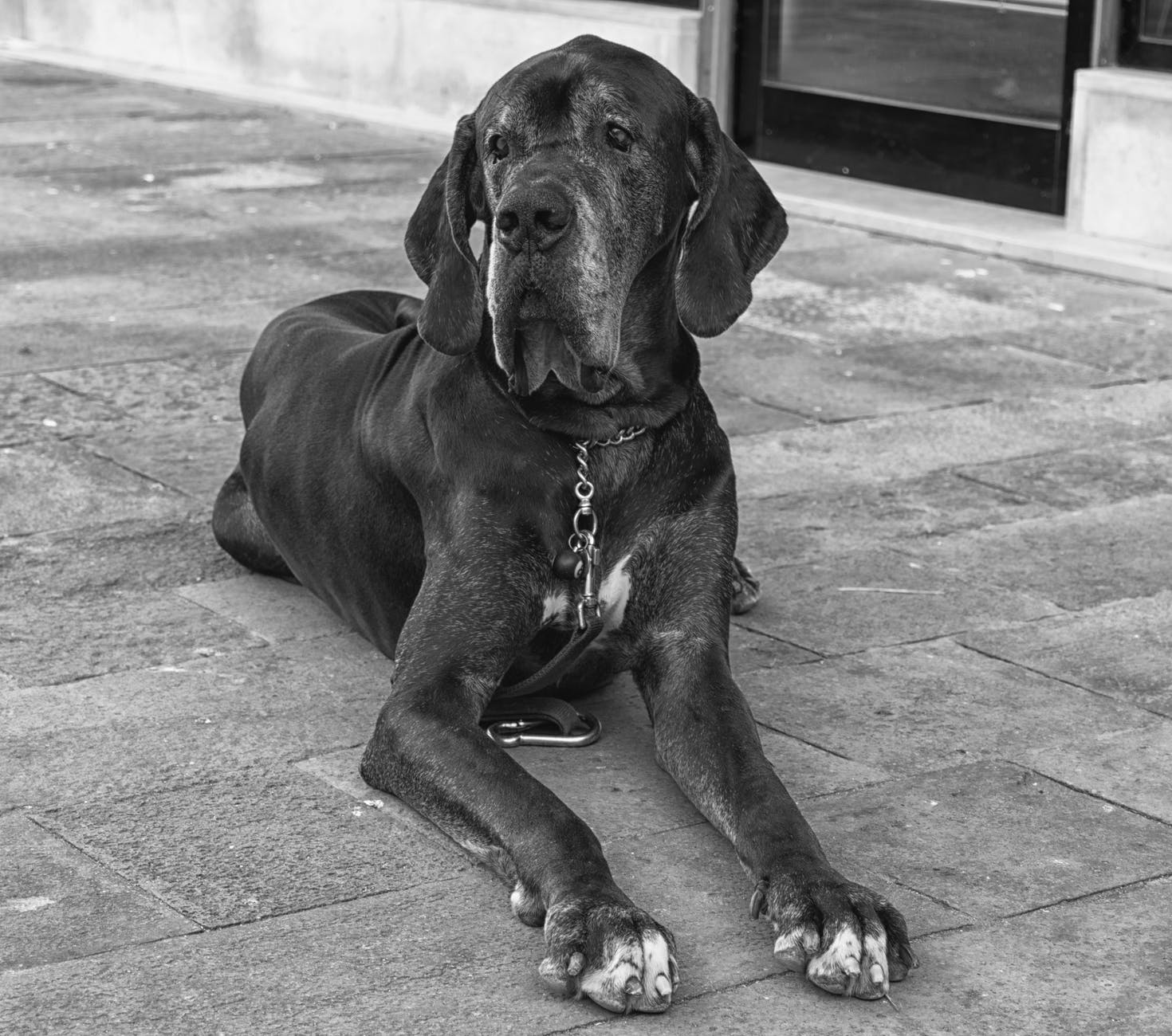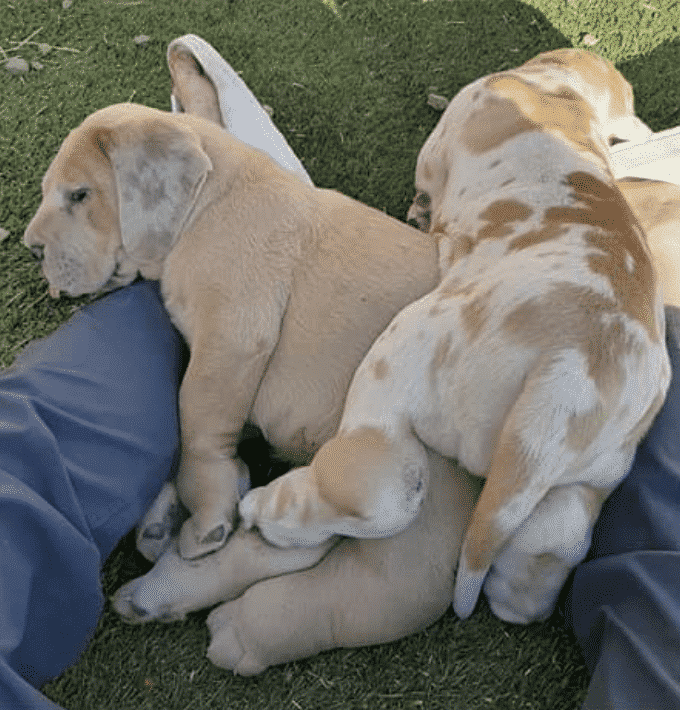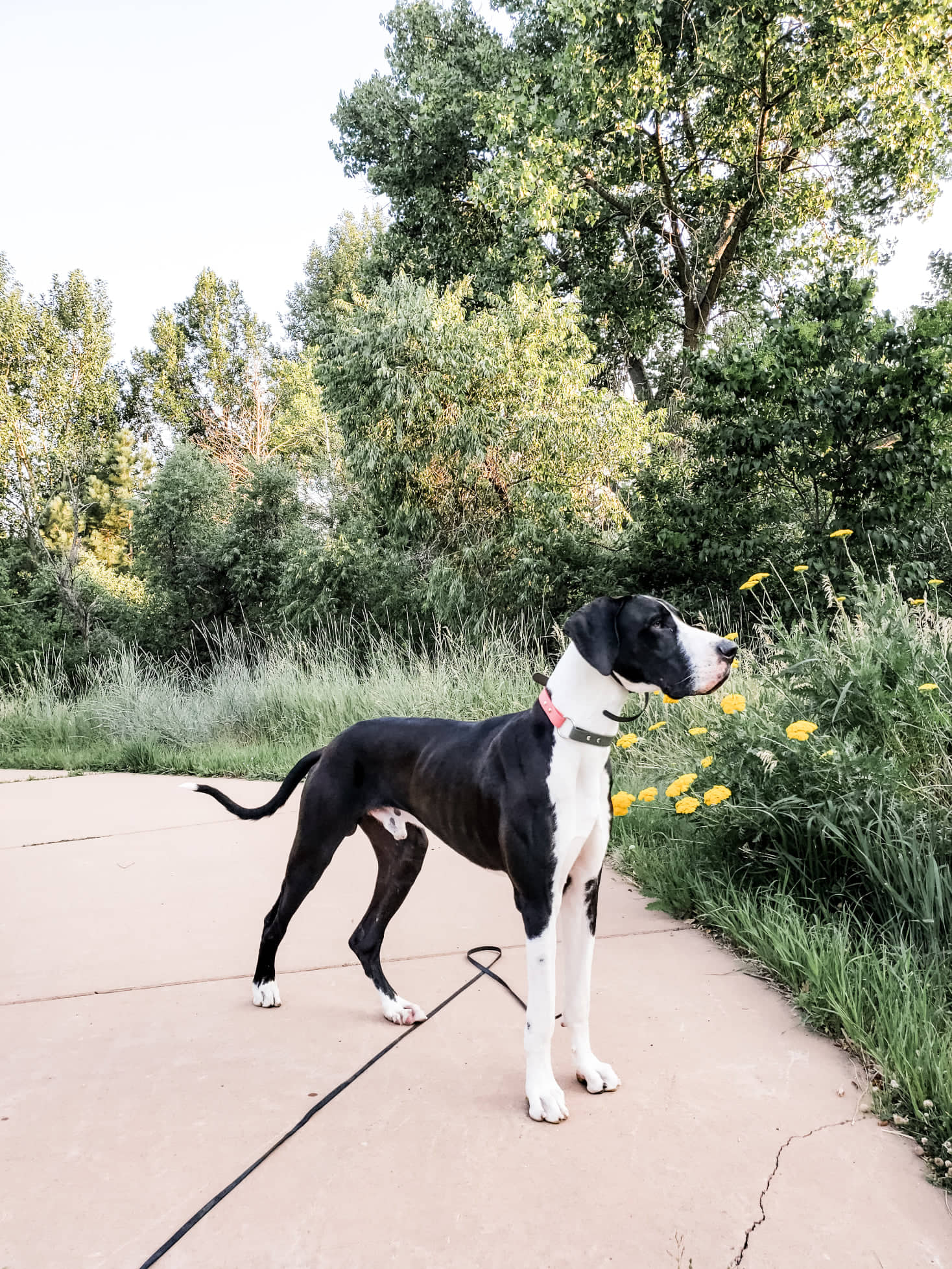Great Danes come in a variety of gorgeous colors. 7 of them are considered ‘standard’ colors, and all others are considered ‘off-standard’ colors. Being ‘off standard’ is not necessarily a bad thing, and if your Great Dane is considered ‘off-standard’ or ‘mis-marked’, it just means they cannot be shown.
There is a growing movement of people who believe more colors should be considered acceptable within the standard and at dog shows. Unfortunately, this is a complicated issue rooted partially in cosmetic preferences that also involve ethics and health. More discussion is definitely needed!
At this time, the standard colors for Great Danes are: Harlequin, Merle, Mantle, Black, Fawn, Brindle and Blue. Each of those colors has even further direction on its presentation, and dogs can fall on a spectrum between fully ‘mis-marked’ to ‘show marked’.

Off Standard Colors in Great Danes
Off standard colors in Great Danes may include ‘Fawnequin’, ‘Chocolate’, ‘Tan Point’, ‘Lilac’, ‘Merlequin’, ‘Brindlequin’, and variations of all of the above (including ‘Lilac Merle’, ‘Lilac Brindle’, ‘White’, ‘Lilac Fawn’, ‘Piebald’, etc.).
Unfortunately, many breeders that focus on creating ‘designer’ colors don’t necessarily focus on health, structure and temperament, and that’s a problem. (See below; lilac fawn merle and fawnequin puppies from an unethical breeder; these puppies have severe edema, which may be indicative of internal health problems).
Flashy colors equal sales, and that’s what some of these breeders want; your money.
Some off-standard colors occur naturally when otherwise thoughtful breeders pair dogs appropriately in their program. Those colors (Fawnequin is a good example) are a good place to start when it comes to considering the addition of more acceptable colors to the written standard.
Off-standard colors can be gorgeous and flashy; make sure you are choosing ethical breeders that are focused first on longevity, structure, and eliminating painful and expensive problems from their pedigree (including bloat, allergies, aggression, dysplasia, heart problems and disorders of the eyes, thyroid and blood).
We have no problem with off-standard colors from ethical breeders.
DOUBLE MERLE DANES
Some off-standard colors in Great Danes are produced by pairing two dogs that carry the Merle gene. Dogs that carry merle include Harlequin, Merle, White, and any coat color ending in ‘quin’.
If a breeder pairs a Merle to a Harlequin, some of the puppies may be ‘Merlequin’, a popular off-standard color that is unethically produced.
Each puppy in the litter will have a 1 in 4 chance of receiving a copy of the merle gene from each parent, making them ‘double merle’.
Double Merle Danes are often deaf or blind and may also have significant, expensive and painful health and temperament problems.
Double Merle Great Danes are 100% preventable. Ethical breeders genetically test all of their dogs (even the ones with solid colors) to confirm the presence of absence of the Merle gene.
Treat cautiously with backyard breeders who will tell you that a white or Merlequin puppy is ‘rare’, and desirable. Entire Great Dane rescues are set up around helping these dogs, who often require veterinary care and training beyond what the average family is able or willing to provide.
It’s also important to note that the breed clubs sometimes encourage breeders to euthanize Double Merle puppies by 5 weeks of age, effectively allowing breeders to pair merle-gened dogs in pursuit of ‘show quality’ or ‘show marked’ Harlequin dogs, with an ‘out’ when they produce unhealthy dogs as a result. We do not support or condone this practice.
HARLEQUIN GREAT DANE
Harlequin Great Danes are very popular, and also the hardest color for breeders to produce both ethically and correctly!
Harlequin dogs most often come from Harlequin + Harlequin (double merle pairing, unethical) OR from Harlequin + Mantle (ethical).
A properly marked Harlequin dog will have a white base coat with torn black patches with a white chest, feet and collar. Some merle patches may also be present and are considered acceptable.
A ‘heavily marked’ or ‘blanketed’ Harlequin will have excessive black and large black patches, which is less desirable in the show ring.
MERLE GREAT DANE
The Merle Great Dane only recently became a standard and acceptable color in the GDCA standard, and can now be shown.
Merle is very similar to Harlequin, except with a grey base coat instead of white. Solid Merle (no white) OR Mantle markings (white socks, chest and full white collar) are considered the ideal markings for Merle Great Danes.
A white dog with patches of merle and no black patches is NOT a merle, but rather a Merlequin and is the result of a double-merle (unethical) breed pairing.
MANTLE GREAT DANE
The Mantle Great Dane is sometimes called a ‘Boston’ Great Dane. It is not to be confused with a mis-marked black Great Dane (Black with white markings) or a piebald Great Dane.
A properly marked Mantle Great Dane has a pure black coat that looks like a ‘blanket’ over the dog, with white socks and/or legs, a white chest, a full white collar, and white on the muzzle. A white blaze on the head is also considered acceptable as are small black spots or ticking in the white areas.
Mis-marks in Mantle Great Danes may include excessive white or excessive black. Brindle Mantle & Merle Mantle are different colors.
BLACK GREAT DANE
A black Great Dane can come from Harlequin, Blue or Black genetics, stressing the importance of genetic color testing before pairing black dogs.
Black Great Danes are pure black with a striking and shiny coat, however mis-marks (white patches on the chest & feet) are not unusual.
Black Great Danes are very common and come from many ethical breedings, however there is an unfortunate truth to the fact that they are often passed over for adoption and purchase. People always want the flashier colors, and may find Black Great Danes to be intimidating.
We think black Great Danes are gorgeous!
FAWN GREAT DANE
Fawn Great Danes are the most famous color. They have a solid golden fawn coat and should have a solid black ‘mask’ on their face that includes black markings around the eyes and on the muzzle.
Markings or colors that appear ‘dirty’, as well as white or black on the chest or feet are considered less desirable.
We’re recently heard that the breeders are seeing less and less of the proper black mask in the fawn lines, perhaps because of indiscriminate breeding practices leading to fewer dogs carrying the necessary genes. Ethical preservation breeders will work to make sure the Fawn mask sticks around.
BRINDLE GREAT DANE
Brindle Great Danes are in the same color family as Fawn.
The coat should have a fawn base layer with evenly distributed black stripes. Brindle Great Danes should have a black mask with black near the eyes and possibly on the ears and tail tip. White patches are considered a mismark,.
Brindle can present in a range of patterns, with some brindle Great Danes showing darker than others. Evenly distributed stripes are preferred.
Off-standard versions of Brindle include Lilac Brindle, heavy or lightly marked Brindle, Mantle Brindle and Brindlequin.
BLUE GREAT DANE
Blue Great Danes are a dilute black that shows up as a beautiful steel blue grey color.
Solid blue is preferred; white, mantle, black, patches or other markings are not desirable. Dark, charcoal or ‘dirty’ blue is also considered a fault.
Some people say that blue Great Danes are more susceptible to skin conditions, bloat, clotting disorders and tumors, however as with any genetic condition indiscriminate breeding for profit is a significant contributing factor.
Choose your breeder carefully, in other words. AKC registration and ‘Euro’ lineage do not automatically make a dog breeding quality.











Leave a Reply